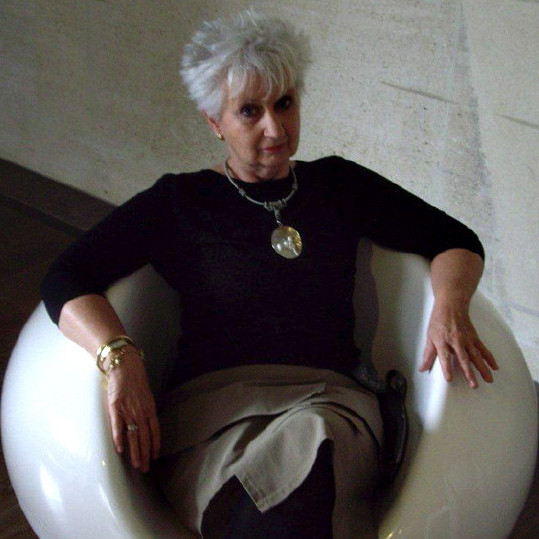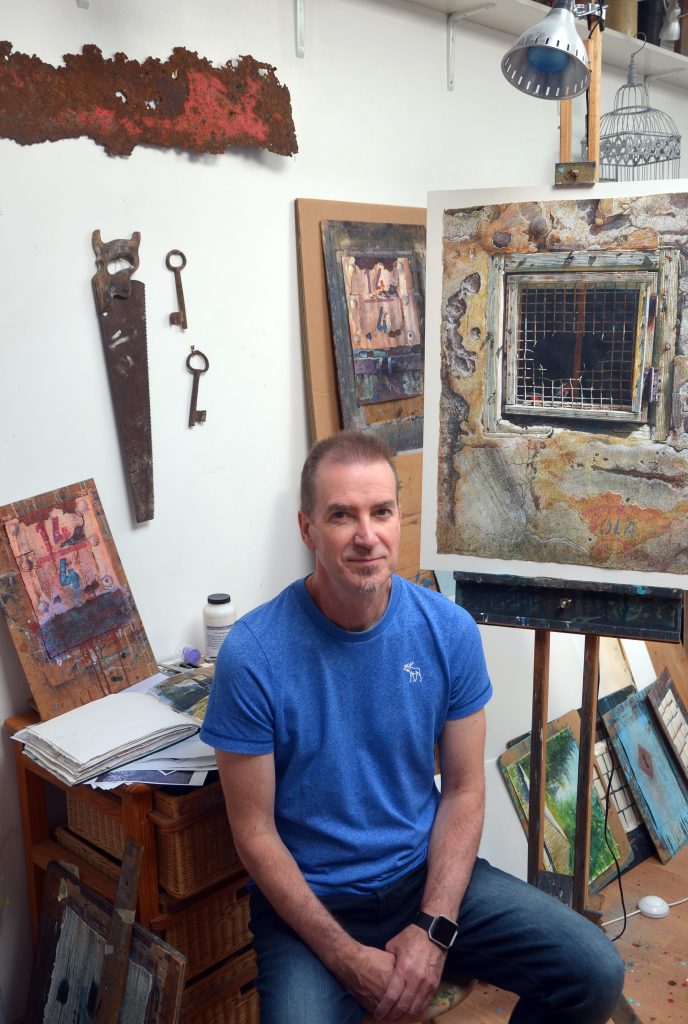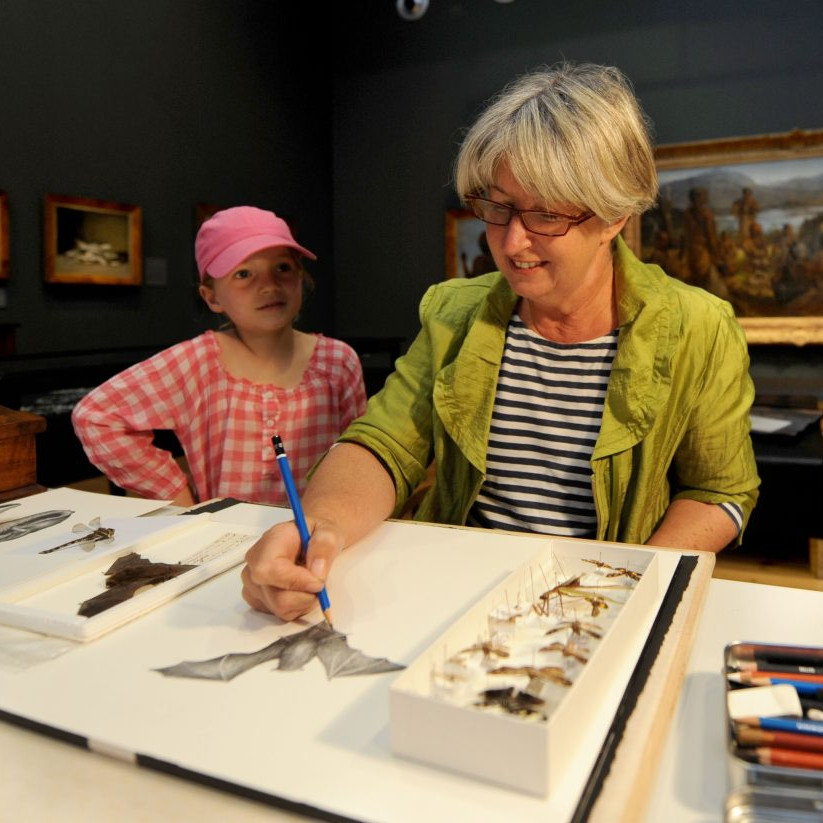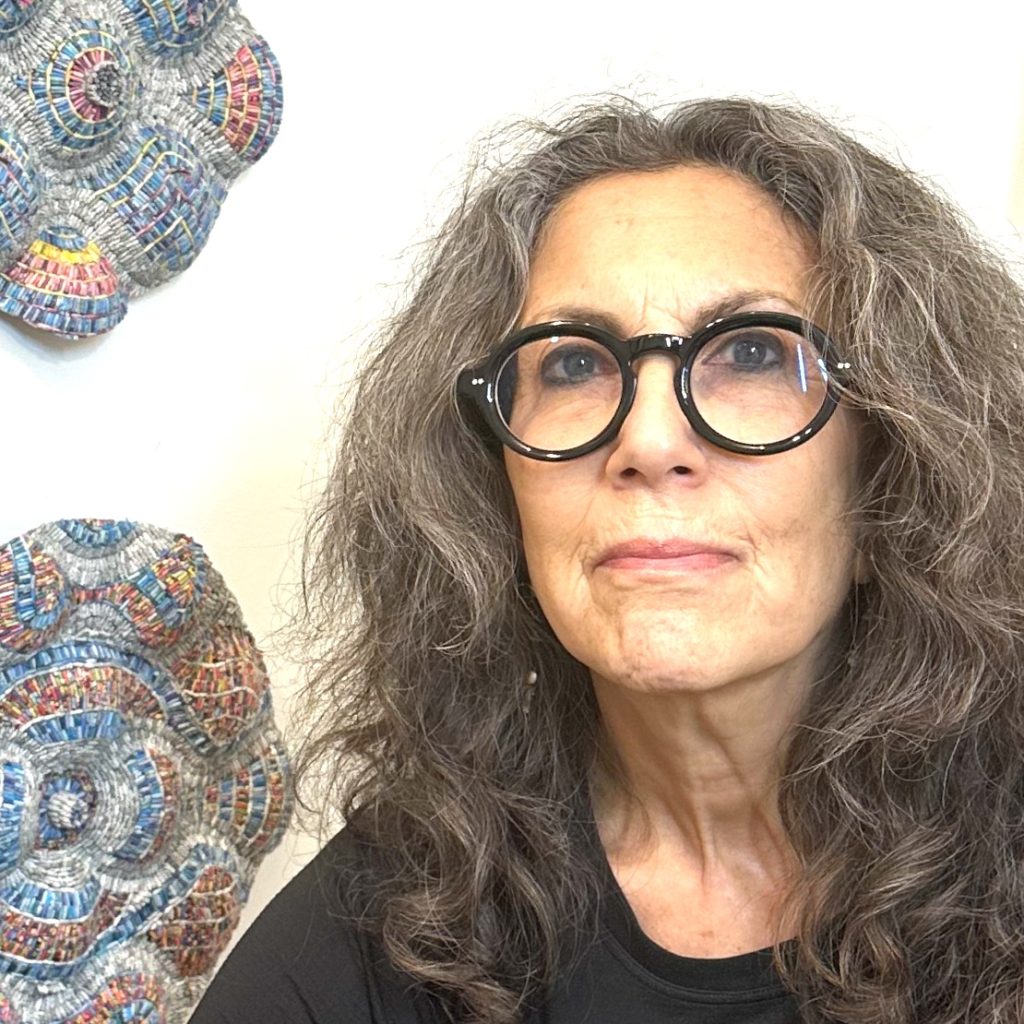Angus McEwan Watercolour Painter
Can you expand on how you paint textures and surfaces?
I work with watercolour to create my textures, exploring surfaces and details that convey each objects identity. I will combine techniques and other types of media with watercolour, including collage and I will employ methods from one media and transfer that to watercolour to create paintings that are non-traditional.
I use collage occasionally to change the surface of the painting. This act alone can enhance the textural element within the image. Collage as a technique is ubiquitous within Scottish, but it tends to be married with oil or acrylic. I wanted to try it with watercolour to see whether it would be successful or not.
I did a series of paintings a number of years back using Cuba as an inspiration and created many of the paintings with a collaged substrate.
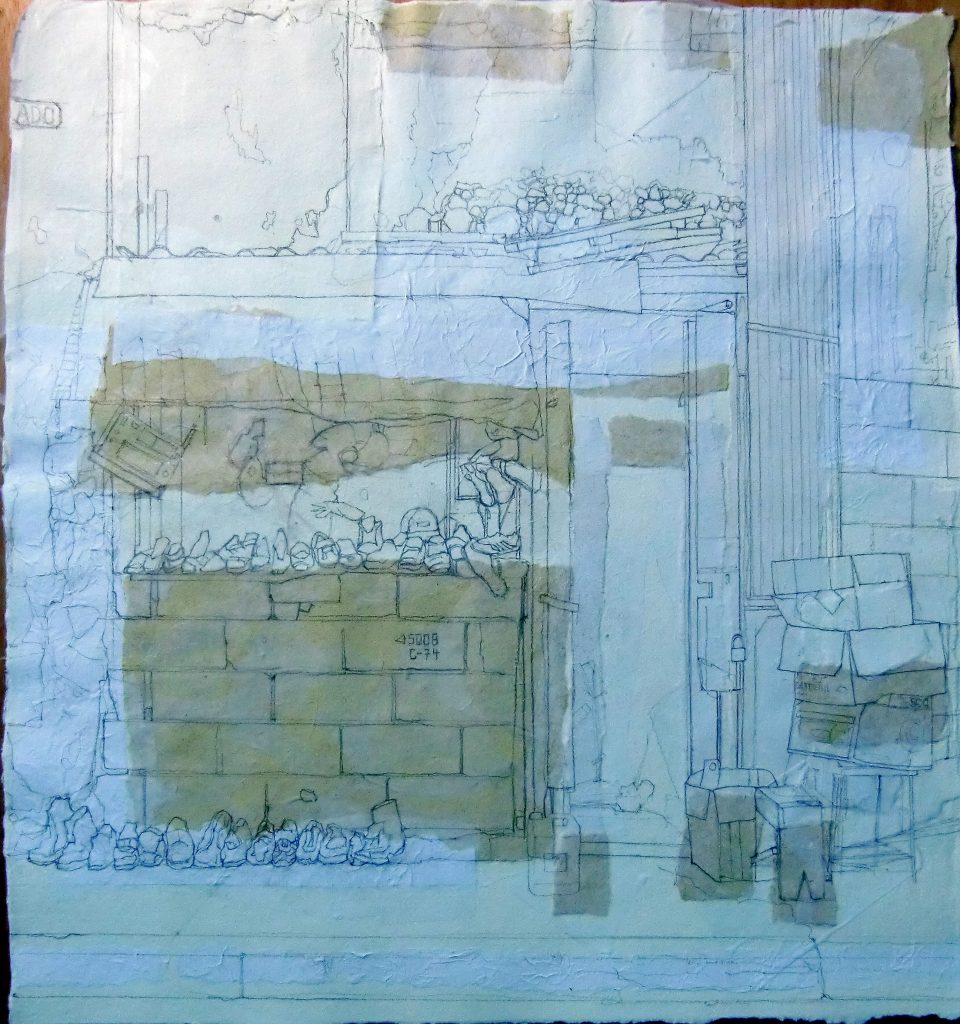
Make do and Mend, 56 x 60 cm, Watercolour on Collage
“Make do and mend”- this painting, as you can see, started off with simplified shapes ripped and placed roughly where I anticipated they would be needed. I then drew carefully the basic outline of the main objects. At this point it is important to ignore the shapes as you draw, it is very easy to be distracted by the collaged pieces as you map out your composition. Once this is worked out, I paint as I normally would as if the collage wasn’t there. The result should be that you aren’t initially aware of the collage but as you look carefully at the painting you will begin to see a textural surface that will enhance the image.
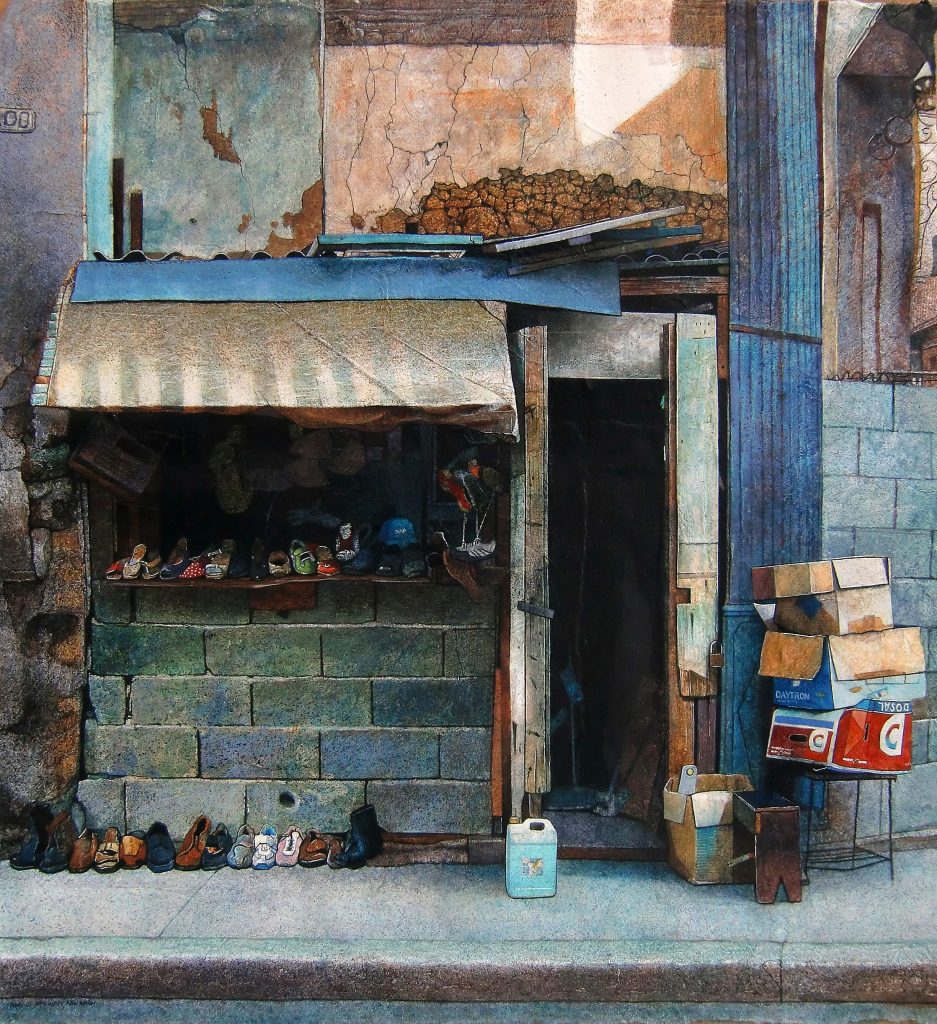
Make do and Mend, 56 x 60 cm, Watercolour on Collage
Another technique that I use in just about every painting is splattering, this also helps me describe surface texture and I use it in multiple ways, wet on wet, wet on dry, masking, no masking, light masking. I usually put down quite a few washes before I start the process of splattering.
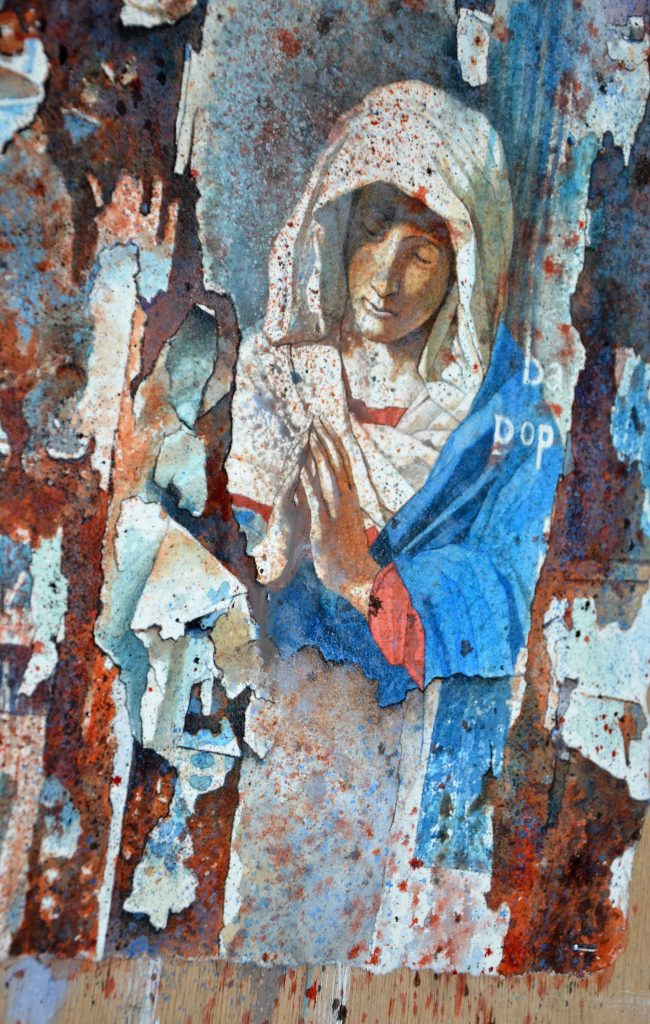 Poster Girl, in progress
Poster Girl, in progress
The image above is a detail of “Poster girl”, watercolour on handmade Fabriano. I wet the surface with a water spray then splattered with a synthetic square headed one stroke brush. This creates arbitrary marks on the surface which can describe texture, tone or colour.
You can see the final painting below and how the area in the bottom right was developed further as I worked with the splattered marks. I also added stamps and stencils to add lettering to the image.
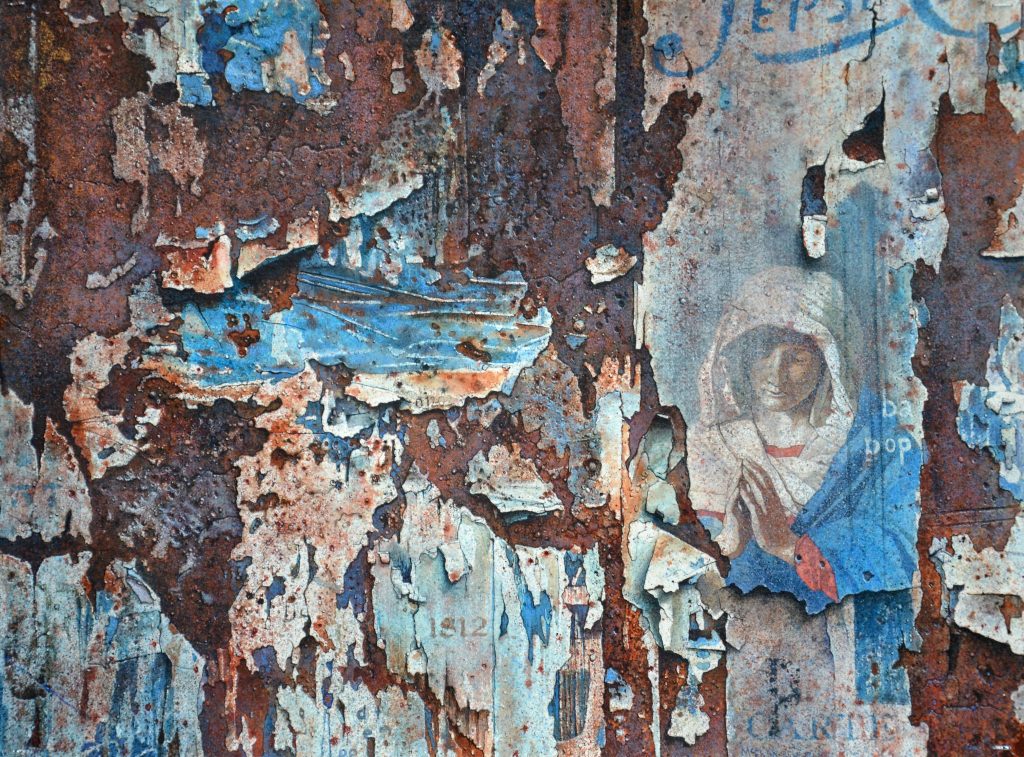
Poster Girl, 41 x 55 cm, Watercolour on Collage
Ageing or falling apart is often the focus of your work – Discuss.
There is nothing like aged material to remind us of our mortality. Even the things we make eventually return to dust. I attempt to record some of the objects I come across as a way of preserving the moment. The objects will either disintegrate, be repaired, replaced, or removed but they will not remain static. The inevitable decline of the objects that attest to our presence on this rock would eventually be wiped away through time. It is my sincerest hope to show the unique qualities in those things that I paint, however decrepit. They are most often unnoticed, ignored or neglected but they all display a degree of inherent beauty that would not be considered traditional. Their decaying surface fascinates me, and I must try to capture this in my work.
When and why did you decide to work in watercolours?
In 1996 I won the Alastair Salvesen Travel scholarship which allowed me to travel to China for 10 weeks. Part of the prize was to have a large one person show in Edinburgh in the Academy buildings, a large space that would need a lot of work. I knew that I would be travelling quite a bit and that I would need to create while on the road. I took a few acrylics and drawing materials with me and decided that watercolour would probably be the most sensible medium to take with me. I worked with the paint a few months before hand to get a feel for it and found the whole process a struggle. It took a few moments of desperation to figure out how to work with the medium. Even now working Plein air gives me a few headaches as its too quick for my normal process of slow methodical washes built up over time.
Due to working in watercolour, does this restrict you to size?
In a word, yes! I work on paper and therefore constrained by the size of the paper. Although you can get rolls of paper, I tend not to go crazy with the size as it just takes me years (literally) to finish the work. I also work on handmade paper and the full sheets are 56 x 76cm and are normally the largest I will work to but occasionally I have a brainstorm and do something larger than that.
Discuss the types of brushes you use?
I use specifically brushes that contain either synthetic hair or synthetic and sable/natural hair mix. I really can’t control pure sable brushes as they never return to the centre when I’m working with them. I hate chasing the point when I’m working. I want to know where the point is everytime, not some of the time.
As far as makers go, I will use very reputable brush manufacturers like Escoda & Da Vinci but I also purchase inexpensive brushes. As long as they do the job. I also like Prolene synthetic brushes and have used them for over 38 years, the brush hairs are amazingly soft and springy.
Take one specific brush that you love using and why?
I use the ½ inch, square headed, one stroke brush by Prolene. When new they provide beautiful consistent small straight washes. When they are old, they are amazing. They will split apart and become an excellent splatter brush, superb stipple brush and provide amazing marks when dragged. They are also good for dry brushing.
How many exhibitions would you work on in a year?
One solo show of around 25/30 pieces or two two-person shows with around 15 pieces. I also try to take part in group shows around the world, as
This can take me all year because I paint slowly (methodically with many washes), and I teach in College part of my week so everything takes longer than it should due to the stop start nature of my time.
You also exhibit outside the UK discuss how different an overseas exhibition is?
The logistics are completely different. Normally overseas institutions need the work well in advance (sometimes 2/3 months) so they have time to frame the paintings. As such the work will be sent unframed, compared to organising the framing myself in a UK based show. A lot of the time you haven’t seen the venue overseas so trust in the people organising the show is a big thing. I usually do due diligence by speaking to others who have worked with or shown with a prospective organiser. In the UK I would normally go and vet the space and meet the people who are working with me. Transport is really a big issue and I have over the years developed a system of packing work that can be used at least twice (there and back). Recently an organiser said to me that my packaged artwork was the best they had ever seen – I do take a good bit of time to put it together.
Discuss the Plein Air Salon Competition.
Every two months the magazine Plein air Salon have an online competition where they select the top 3 painting overall and winners from each section from the work submitted. The work, despite the name doesn’t have to be completed in plein air. At the end of the year they select finalists from the section winners (from the year) to have the opportunity to win the grand prize of $15,000 (USD). The final prize-winning selections however reflected the Plein air title, so it does seem to be important.
Why you entered?
This is an online competition which appealed to me due to the fact I don’t have to send my paintings overseas.
The work you entered
I have entered a number of work; “Beating heart of China” won best Vehicle April/May; Tea Break was selected as Annual finalist for the 8th PleinAir salon: “Shroud of Qingdao” was also selected as Annual finalist for the 8th PleinAir salon; Tea Break” won best watercolour in August/September 2018; “Contemplation” won 1st place overall: $1000; Shroud of Qingdao” won best watercolour June/July 2018.
Technically, discuss the work.
Not sure what you are looking for here? Each of the paintings were very different some took 6 months others were a lot quicker. All were watercolour.
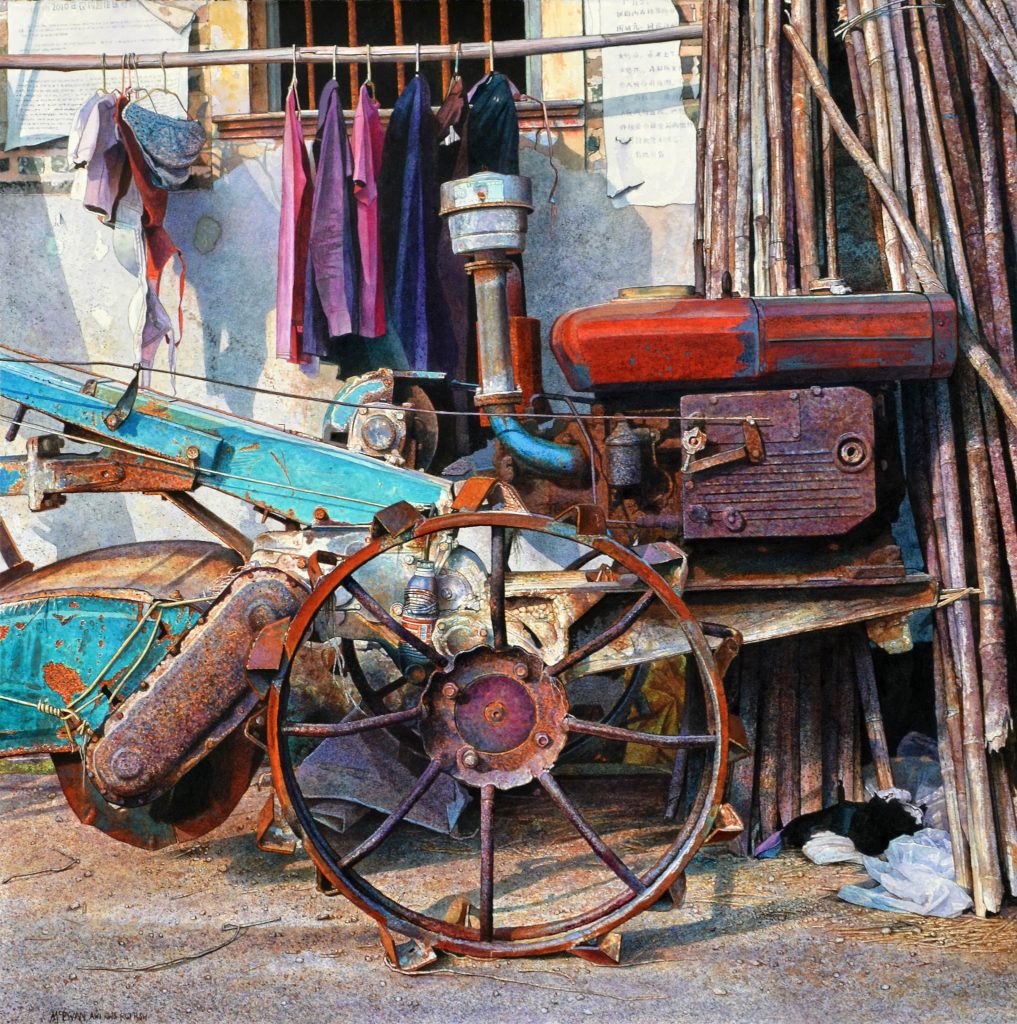
Beating heart of China, 57 x 56 cm, Watercolour
“Beating heart of China”-took many months and was quite challenging as there were so many different aspects to the painting. I really wanted this to wow! I therefore spent along time making sure each area made sense. There weren’t many opportunities to be careless with the paint and I do like some parts of the painting to have an element of serendipity or chance involved in it at some point.
“Tea Break” had to be planned and drawn carefully as I wanted it to be an accurate representation of the moment. I also used the paper for my white areas, so this had to be painted around in a methodical way as I don’t use masking fluid. Watercolour on handmade Fabriano. “Tea break”, is a moment in time preserved for eternity, the point when someone puts their cup and newspaper down on the desk and walks out the door never to return. Why have they not returned? Why did they not come back for their coat or clean the mug or put the paper in the bin?
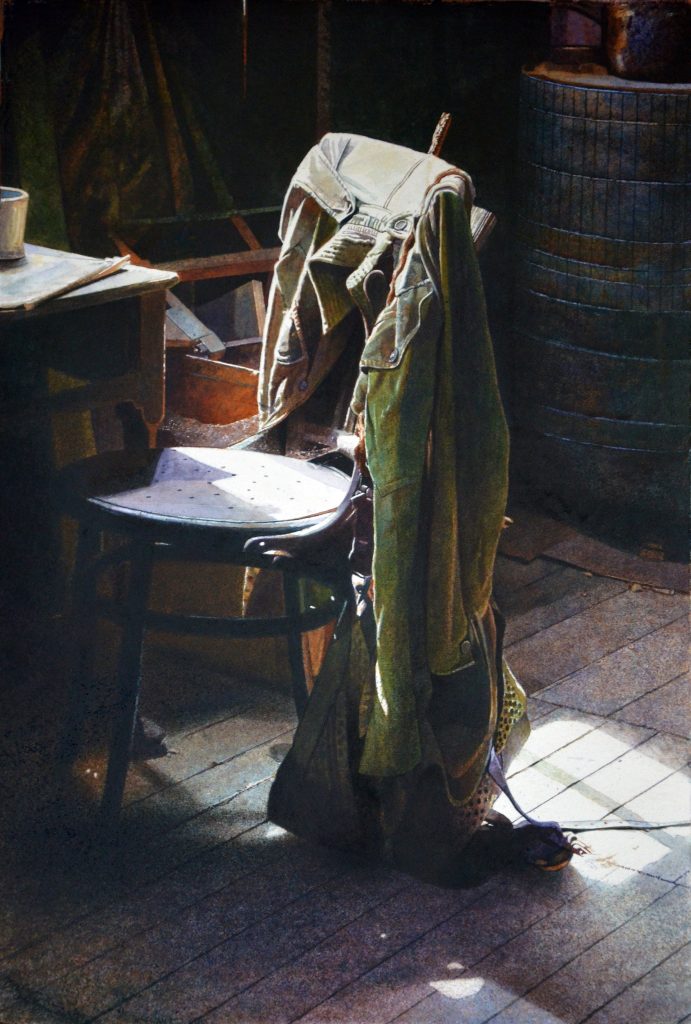
Tea Break, 56 x 38 cm, Watercolour
“Shroud of Qingdao” I came across this boat on a beach one late November day while on a visit to Qingdao to attend the opening of an exhibition. I was immediately taken with the boat which had obviously been half buried on purpose and covered with a rough, thick blue cloth to protect it from the elements. Having very little time I drew a few of the boats which took my eye, but I knew this one was going to be particularly interesting to paint. I spent 6months painting every single stone with a 2/0 paintbrush.
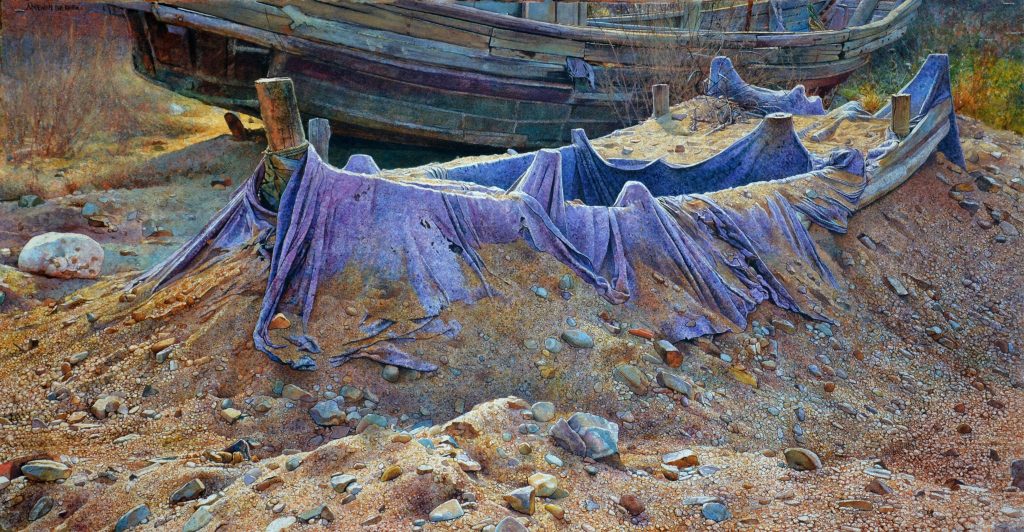
Shroud of Qingdao, 55 x 103 cm, Watercolour
“Contemplation”, this was a very interesting painting to do as it has the bulk of the subject matter at the top end of the painting. There are very few colours involved and I wet and rewet the floor surface to produce the polished floor. I found the “magic” sponge to be a huge help when creating the light part of the floor.
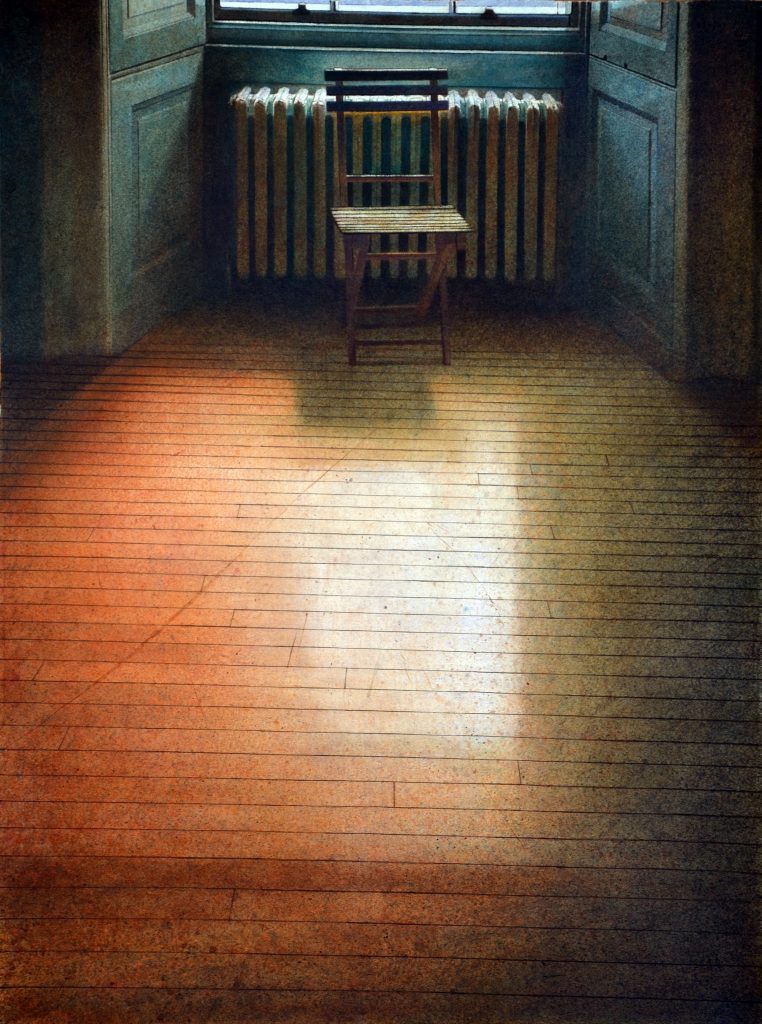
Contemplation, 76.5 x 57.5 cm, Watercolour
What is the importance of international awards?
Personally, it’s a vindication that the work I’m creating is comparable to other artists, not just in the UK, but worldwide. It’s a huge compliment and I find that my place in the art world is not just focussed on Scotland or the UK anymore but globally.
I am much more aware of what is going on in other countries than used to be and as a result I think it helps motivate me to be a more accomplished painter.
In your words discuss watercolour and how they are perceived or miss perceived by the general public and even galleries.
Watercolours, especially in the UK, get a bad rap. Often seen as being the domain of Sunday painters or amateurs. Truth be told it is a most difficult medium to master and much trickier to work with compared to Oils or Acrylics. I teach all of them at College and watercolour is the one medium that can make an accomplished artist look less than capable. For that reason alone, it should get more respect from the public, Galleries, Museums and even some artists. The other reason it doesn’t seem to get a lot of respect is that it was used historically as a medium to work out compositions or to paint Plein air. It was used by many painters in 18th Century to help with their studio oil paintings. I also believe that the fugitive nature of early watercolour paints meant it was not something you would want to use for serious work.
Now however, the quality and consistency of professional paints are very stable and barring leaving your work in a greenhouse it will certainly be around a lot longer than it used to. Just consider Albrecht Durer’s work “Young hare” from 1502, its amazingly fresh and it’s a watercolour on paper.
Watercolour is certainly worth investing in as an artist and a buyer. I have found that it is incredibly popular around the world, especially in China and the US
Discuss ‘Out of Sync’
Where did you find this image?
This was a door in Fabriano, Italy and one that I have looked at many times over the past 6 years.
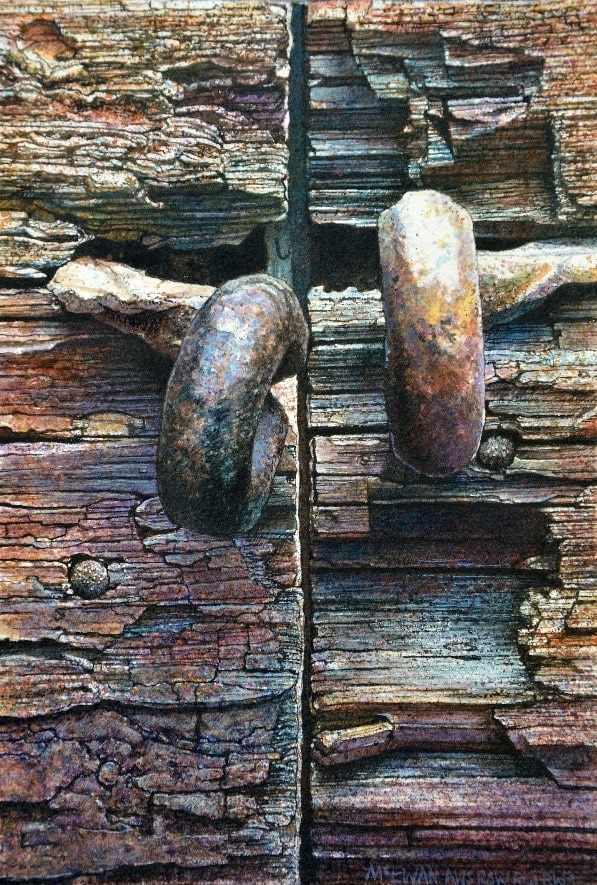
Out of Sync, 22 x 21 cm, Watercolour
Composition
I wanted to focus down closely so that the image almost became a landscape. It’s something I’ve wanted to do for a while. It really becomes quite abstract if there isn’t a hook that can take you into the image. I divided the painting into two halves although it isn’t exactly in the centre, this compositionally, is a no, no! I do it all the time, so long as there is something that can take your eye across the chasm it will work. One of the metal hoops breaks the line and therefore disrupts the division.
Colour
I work with my colours as pure (from the tube) washes. What I mean by that is that I don’t mix my paint very often. Its all done by layering on the surface. I advance the colours by alternating warm & cool washes. The overall image is warmer and more towards burnt orange tones and the bottom is darker and heads towards a bluer/violet red. The darker wash at the bottom provides stability to the image
Texture
Wood & metal. I love texture but I especially enjoy painting the texture of wood and metal. It has to be said that in this instance the colours are quite muted for my work however it was the strong tones that appealed to me. I had to make sure the basic tonal structure was accurate everything else I can create from my imagination.
Comment on your interest in locks, using three images to show your fascination.
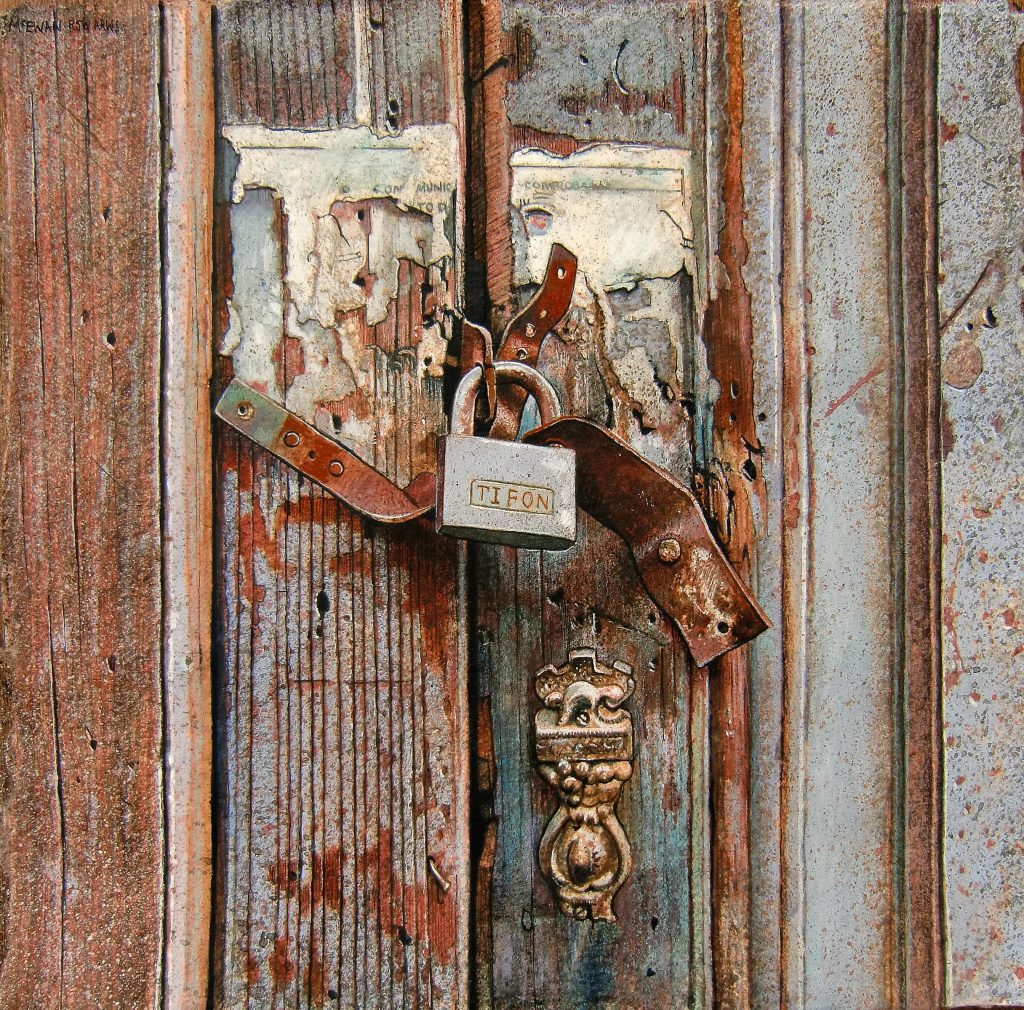
Busted-Cuba, 21 x 15 cm, Watercolour on collaged surface.
I love doors and locks are part of that fascination. They tend to offset the vertical aspect of a door and woodgrain with a horizontal metallic bar or clasp. An opportunity to have a foil in the composition. In the instance of “Busted the metal clasp is twisted into interesting diagonals which I echoed in the scratch in the door.
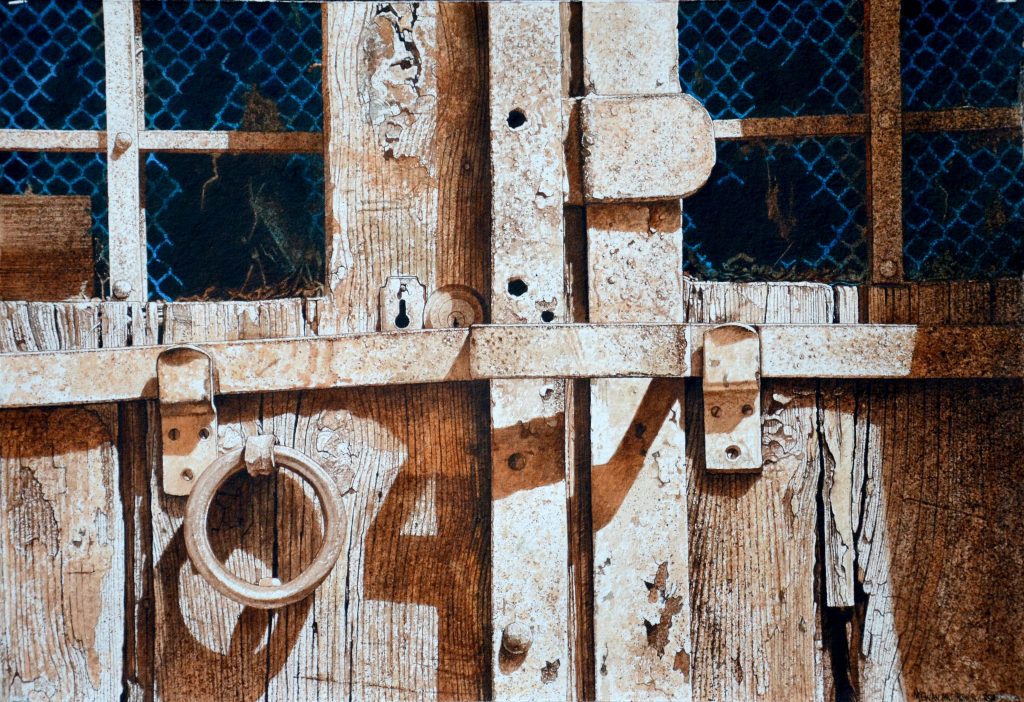 Brown Out, 38 x 55 cm, Watercolour on handmade Fabriano.
Brown Out, 38 x 55 cm, Watercolour on handmade Fabriano.
This is a relatively new painting and is currently on show in Bulgaria. The main thing for me was to emphasise the bleached-out colour of the door with the beautiful blue wire mesh in the dark of the window panels. It was tricky resisting the urge to balance out the warm colours with washes of blue. I had to stop myself many times.
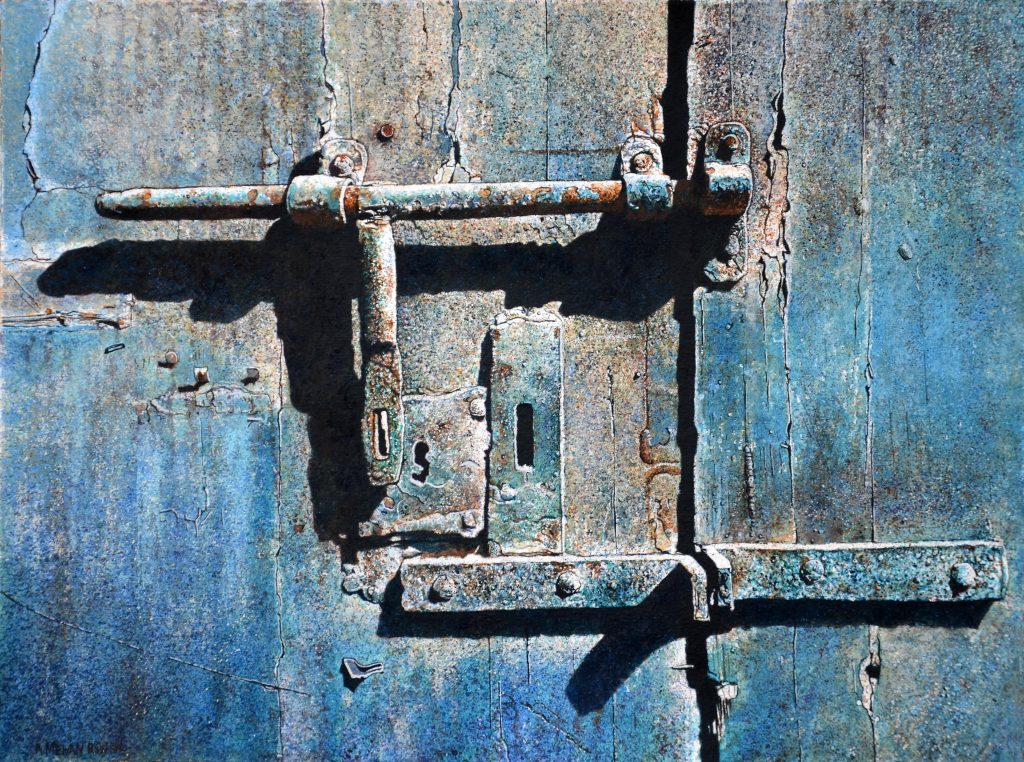 Coming Apart at the Seams, watercolour on handmade Fabriano.
Coming Apart at the Seams, watercolour on handmade Fabriano.
This is a slightly older painting although it is one, I returned to recently to try out another method of working. The original door was green, and I’m not very found of green to work with and prefer a Manganese Blue colour (although it is more complicated than that).
This painting has turned out to be one of my more popular image as I have come across a few imitations on the web over the years.
Take one painting that has propelled your career and why has it?
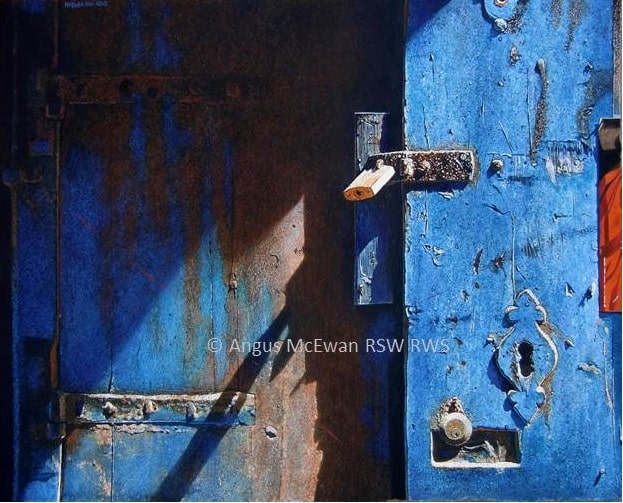
Slipping into the shadows, 52 x 65cm, watercolour on Fabriano Artistico.
This was the first International watercolour competition outside of the UK that I entered, and I won the Bronze award. The exhibition was one of the largest watercolour exhibitions in the world at the time-Shenzhen Watercolour Biennial China 2013-2014.
I decided to travel to China for a few days to pick up the award and through this I met many people who have been very influential in many aspects of my career ever since. This painting has probably created the road I am now travelling on. So many opportunities and friendships have been developed from this exhibition and it has opened many doors ever since. I am very grateful to have had this opportunity.
Contact details:
Angus McEwan AWI RSW RGI RWS
Deborah Blakeley, Melbourne, Australia
Interview by Deborah Blakeley, August 2019
Think a colleague or friend could benefit from this interview?
Knowledge is one of the biggest assets in any business. So why not forward this on to your friends and colleagues so they too can start taking advantage of the insightful information the artist has given?
Other artists you may be interested in:

